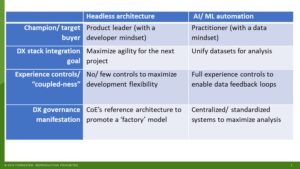Thoughts On DX: Headless Vs. AI/ML
I have been noodling on the future of digital experience (DX) for the better part of six years. Today I want to run a hypothesis past you:
Headless architecture and AI/machine-learning (ML) automation are competing for the future (and soul) of the DX tech stack.
So let’s examine both sides of this equation:
1.) Headless, oh headless . . . this has been an onrushing tide for three-plus years and shows no signs of slowing. This trend originated in multiple areas of DX, especially with a few of the earliest entrants: SendGrid for email, commercetools for commerce, and Contentful for content management system (CMS). Today, there are dozens of “headless” solutions in every category. Some headless branding is well earned; some is a little more questionable. (Recently, I “found” headlesscms.org maintained by Netlify. It’s a good list of solutions, but I am not clear on why headless CMSes only matter to JAMstack. I am looking forward to conversations with Netlify on this aggregation of providers. But I digress . . . ). Headless promises to free developers and product leaders from full-stack systems that are harmful to employ for reuse of common core services and ultimately slow or restrict development efforts.
2.) AI/ML is permeating every conversation from ethics to automation to the future of work, all the way up to the dangers that AI may pose to humanity. I don’t pretend to reach that high, but my colleagues and research director have been looking at “smart DX” as a good manifestation of AI/ML that enables us to bring higher quality and scale to mundane tasks such as tagging rich media. Today’s flavor of AI/ML is predominately based on deep learning, and that technique demands larger and higher-quality data sets to train the model. Ultimately, AI/ML is edging into today’s human DX tasks: AI/ML will inform experience layout, AI/ML will create content variants, AI/ML will run code QA analysis, AI/ML will examine behavioral analytics to find new segments, and much more.
You should start to see where these two trends may be at odds within DX tech stack priorities. When you put these two trends side by side, it looks something like this:
 What do you think? Am I on to something? Is it possible to have both? I am looking forward to your comments and discussions.
What do you think? Am I on to something? Is it possible to have both? I am looking forward to your comments and discussions.